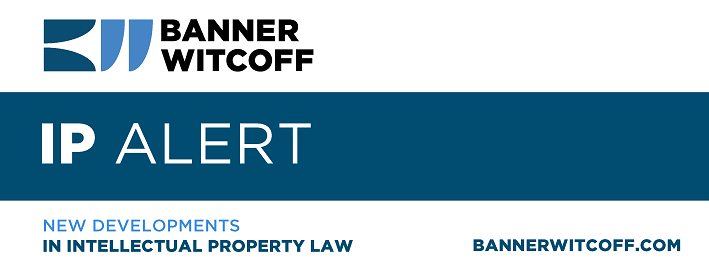
When is Simply Having a Good Idea Insufficient?
Nuvo Pharmaceuticals v. Dr. Reddy’s Laboratories Inc.
The written description requirement of 35 U.S.C. § 112 is generally considered a distinct criterion of patentability, separate from the enablement requirement. Less than a decade ago, the U.S. Court of Appeals for the Federal Circuit affirmed that this was so, pointing to a long legal pedigree. Ariad Pharmaceuticals, Inc. v. Eli Lilly and Co., 598 F3d 1336 (Fed. Cir. 2010) (en banc). The contours of the written description requirement continue to be shaped, especially in the context of pharmaceuticals. One new contour was carved in the Federal Circuit’s May 15 opinion in Nuvo Pharmaceuticals (Ireland) Designated Activity Co. v. Dr. Reddy’s Laboratories Inc., Case 2017-2473 (Fed. Cir. 2019).
Nuvo held patents to solid drug formulations that comprise an encapsulated non-steroidal anti-inflammatory drug (NSAID) and an acid inhibitor, at least a portion of the latter not being encapsulated. The encapsulation of the NSAID prevents the release of the NSAID from the solid formulation until the acid inhibitor counteracts the acid in the stomach and upper small intestine, causing the pH to rise to at least 3.5. When the NSAID is released in the less acidic environment, theory suggests that the NSAID will cause fewer damaging side effects to the upper gastrointestinal tract.
A technical wrinkle in the scheme to achieve sequential release of the acid inhibitor and the NSAID is that the proton pump inhibitors (PPIs), a type of acid inhibitor, are sensitive to degradation by the acidic environment of the upper gastrointestinal tract. Thus, the invention’s use of at least some acid inhibitor that is not encapsulated ran contrary to the notions in the art at the time.
The defendant-appellants (generic drug companies) had filed for U.S. Food and Drug Administration approval of their generic versions of Nuvo’s solid drug formulation using the Abbreviated New Drug Application (ANDA) procedure, piggy-backing on the prior approval of the branded drug/patent holder. The generic drug companies contended at trial that the patents were invalid for lack of enablement, lack of adequate written description, and for obviousness. The U.S. District Court of New Jersey upheld the patents with regard to each of these criteria of patentability. However, the appellate panel disagreed with the trial court’s conclusion of adequate written description. The panel — in an opinion penned by Judge Raymond C. Clevenger III on behalf of Chief Judge Sharon Prost, Judge Evan J. Wallach, and himself — found that not only was the district court’s conclusion unsupported by its analysis, but also the panel’s own review of the record failed to find support for the conclusion.
The key factors supporting the appellate panel’s decision overturning the district court’s holding of adequate written description were: (a) the failure of the specification to provide any data showing efficacy; (b) the failure of the specification to provide any explanation of the purported efficacy; and (c) patent owner Nuvo’s persuasive showing at trial (in rebutting the defendant’s assertion of obviousness) that those of skill in the art would not have expected efficacy. The appellate panel justified its conclusion with an orderly progression of legal principles. First, the panel stated that merely having the words of the claim in the specification is not always sufficient because the words “may not both put others on notice of the scope of the claimed invention and demonstrate possession of that invention.”[1] Second, the panel reiterated the established principles from case law that, on their own, might have led to a favorable disposition: (a) data demonstrating effectiveness is not required; (b) a theory or explanation of efficacy is not required; and (c) reduction to practice is not required. Although these three elements are generally not required, the panel concluded that in this case, where a person of skill in the art would not have had a reasonable expectation of efficacy, that person would not have understood that the invention is effective from such a bare-bones specification. The person of skill in the art would not have understood that the inventor was in possession of the invention at the time of filing.
The panel was careful to qualify its holding as fact-specific. It justified the outcome by pointing to three specific factors in this case: the claims recite a result (therapeutic efficacy), the specification fails to provide any data, and the specification fails to provide any explanation why the invention would work. One can expect creative litigants to challenge the adequacy of a patent’s written description in other situations where they can argue that the specification did not put others on notice of the scope of the claimed invention or demonstrate possession of the invention.
Practice Notes
Did the plaintiff patentee make a strategic error in advancing two inconsistent arguments with regard to written description and obviousness? Previously, these two issues may not have seemed to be in opposition. If drafting an application for an invention whose non-obviousness may rely on “no reasonable expectation of success” in the art, this case counsels toward inclusion of data and/or explanations that could overcome any negative expectation.
On appeal, the panel rejected Nuvo’s five claim
construction arguments because Nuvo had not raised them at trial. By restating each argument separately and
finding each argument waived or forfeited, the court seemed to telegraph to
future appellants and appellees its pique that it had to address improperly
raised issues. The opinion is a reminder
not to use an appeal as a second bite at a trial strategy.
Click here to download a printable version of this article.
[1] The panel cited Enzo Biochem. v. Gen-Probe, Inc., 323 F.3d 956,968-969 (Fed. Cir. 2002).
Posted: May 30, 2019


